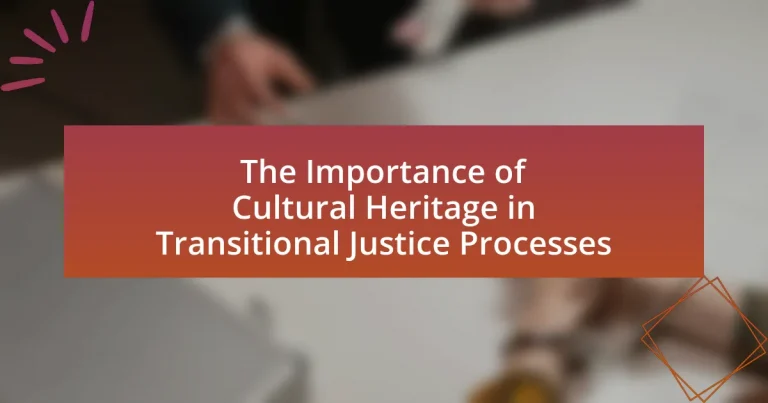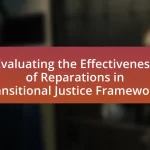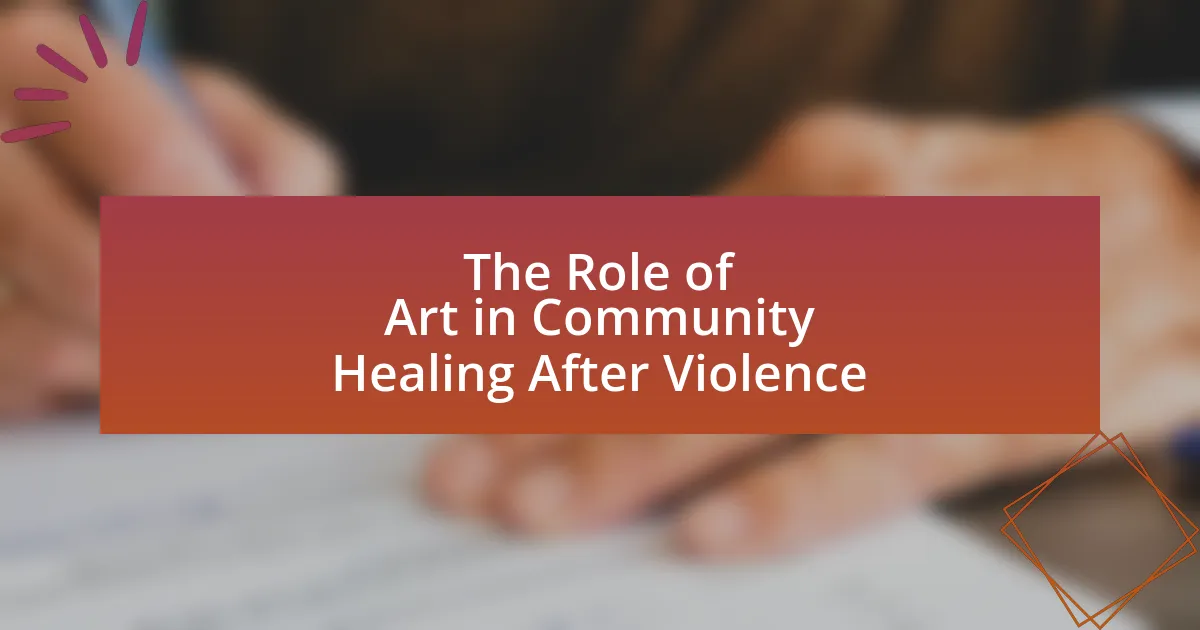Cultural heritage is a vital component in transitional justice processes, playing a significant role in fostering reconciliation and restoring community identity following conflict. The article examines how cultural heritage influences the goals of transitional justice, emphasizing its importance in truth-telling, reparations, and social cohesion. Key components such as tangible and intangible heritage, along with collective memory, are discussed in relation to their impact on healing and identity restoration. The article also addresses the challenges of integrating cultural heritage into transitional justice frameworks, the influence of political factors, and the essential role of local communities and international organizations in advocating for preservation efforts. Ultimately, effective integration of cultural heritage can enhance social cohesion and contribute to long-term peacebuilding in post-conflict societies.
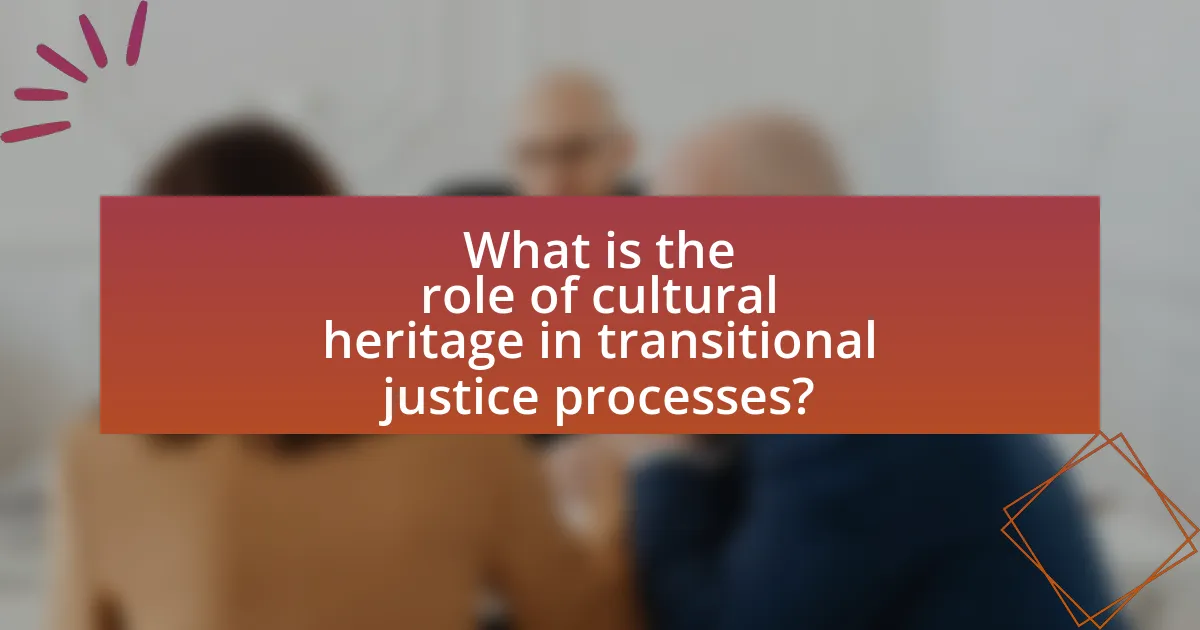
What is the role of cultural heritage in transitional justice processes?
Cultural heritage plays a crucial role in transitional justice processes by fostering reconciliation and restoring community identity after conflict. It serves as a means to acknowledge past injustices, allowing societies to confront their histories and promote healing. For instance, the preservation of historical sites and artifacts can symbolize resilience and continuity, helping communities to rebuild their narratives. Furthermore, studies have shown that integrating cultural heritage into transitional justice frameworks enhances public participation and strengthens social cohesion, as evidenced by initiatives in countries like South Africa and Rwanda, where cultural heritage was pivotal in truth-telling and memorialization efforts.
How does cultural heritage influence the goals of transitional justice?
Cultural heritage significantly influences the goals of transitional justice by shaping collective memory and identity within post-conflict societies. This influence manifests in the prioritization of truth-telling, reparations, and reconciliation processes that honor and preserve cultural narratives. For instance, in countries like South Africa, the Truth and Reconciliation Commission emphasized the importance of acknowledging historical injustices tied to cultural identity, which facilitated healing and social cohesion. Additionally, the preservation of cultural sites and practices serves as a means of restoring dignity to affected communities, reinforcing the idea that justice is not solely about legal accountability but also about cultural recognition and restoration.
What are the key components of cultural heritage relevant to transitional justice?
The key components of cultural heritage relevant to transitional justice include tangible heritage, intangible heritage, and collective memory. Tangible heritage encompasses physical sites, monuments, and artifacts that hold historical significance, which can be crucial for acknowledging past injustices and fostering reconciliation. Intangible heritage refers to traditions, languages, and practices that shape community identity and resilience, playing a vital role in healing and restoring social cohesion. Collective memory involves the shared recollection of past events, which influences how societies understand their history and navigate the process of justice. These components collectively contribute to the recognition of rights, the promotion of accountability, and the facilitation of dialogue in transitional justice frameworks.
How does cultural heritage contribute to reconciliation in post-conflict societies?
Cultural heritage contributes to reconciliation in post-conflict societies by fostering a shared identity and promoting dialogue among diverse groups. This shared identity helps to bridge divides created by conflict, as cultural heritage often embodies common values, traditions, and histories that can unite individuals. For instance, initiatives that involve the preservation of cultural sites or the celebration of traditional practices can create opportunities for collaboration and understanding, allowing former adversaries to engage in meaningful interactions. Research indicates that communities that actively engage with their cultural heritage during reconciliation processes experience improved social cohesion and reduced tensions, as evidenced by case studies in countries like Rwanda and Bosnia, where cultural heritage projects have played a pivotal role in healing and rebuilding trust among communities.
Why is the preservation of cultural heritage important during transitional justice?
The preservation of cultural heritage is crucial during transitional justice because it fosters social cohesion and reconciliation in post-conflict societies. By maintaining cultural heritage, communities can retain their identity and shared history, which is essential for healing and rebuilding trust among diverse groups. Research indicates that cultural heritage plays a significant role in the collective memory and identity of communities affected by conflict, as seen in the case of Bosnia and Herzegovina, where the preservation of cultural sites has been linked to efforts in promoting peace and understanding among ethnic groups.
What are the risks of neglecting cultural heritage in transitional justice efforts?
Neglecting cultural heritage in transitional justice efforts risks undermining social cohesion and perpetuating cycles of violence. When cultural heritage is ignored, communities may feel alienated and marginalized, leading to increased tensions and potential conflict. For instance, the destruction of cultural sites during conflicts, such as in Syria, has not only erased historical identity but has also fueled resentment among affected populations, hindering reconciliation processes. Furthermore, neglecting cultural heritage can result in the loss of traditional knowledge and practices, which are vital for community resilience and identity. This loss can diminish the effectiveness of transitional justice mechanisms, as they often rely on shared cultural narratives to foster understanding and healing among divided groups.
How can cultural heritage serve as a tool for healing and identity restoration?
Cultural heritage can serve as a tool for healing and identity restoration by providing a sense of belonging and continuity for individuals and communities affected by trauma. Engaging with cultural practices, traditions, and historical narratives allows individuals to reconnect with their roots, fostering resilience and a renewed sense of identity. For instance, studies have shown that communities that actively participate in cultural heritage activities, such as storytelling, rituals, and art, experience improved mental health outcomes and social cohesion. The United Nations Educational, Scientific and Cultural Organization (UNESCO) emphasizes that safeguarding cultural heritage contributes to peacebuilding and reconciliation efforts, as it helps restore dignity and fosters mutual understanding among diverse groups.
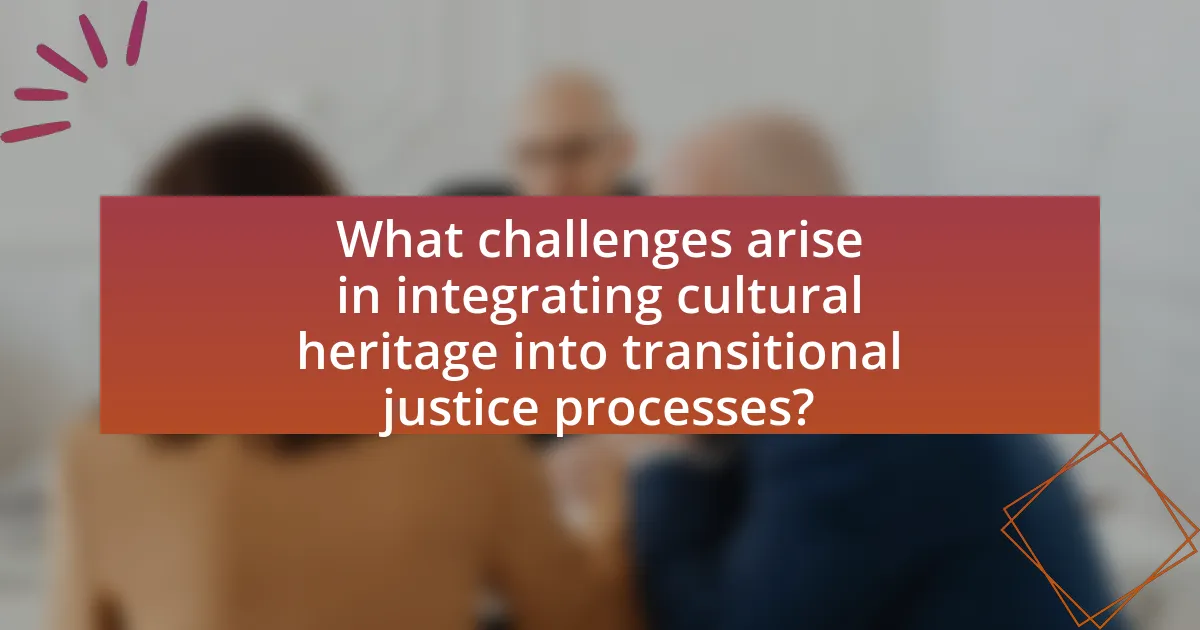
What challenges arise in integrating cultural heritage into transitional justice processes?
Integrating cultural heritage into transitional justice processes faces several challenges, primarily due to conflicting narratives and the politicization of heritage. These challenges arise because cultural heritage often embodies diverse historical perspectives, which can lead to disputes over its representation and significance. For instance, in post-conflict societies, different groups may claim ownership of cultural sites or artifacts, complicating efforts to create a unified narrative that supports reconciliation. Additionally, the prioritization of legal and political frameworks in transitional justice can overshadow the importance of cultural heritage, resulting in inadequate attention to its preservation and integration. This dynamic can hinder the effectiveness of transitional justice initiatives, as cultural heritage plays a crucial role in fostering collective memory and identity.
How do political factors affect the recognition of cultural heritage in transitional justice?
Political factors significantly influence the recognition of cultural heritage in transitional justice by shaping the narratives and priorities of post-conflict societies. Governments and political leaders often determine which aspects of cultural heritage are acknowledged or marginalized based on their agendas, power dynamics, and the need for national reconciliation. For instance, in the aftermath of the Rwandan Genocide, the government prioritized the recognition of certain cultural sites and practices that aligned with its vision of unity, while neglecting others that could evoke divisions. This selective recognition can either facilitate healing and reconciliation or exacerbate tensions, as seen in various transitional justice frameworks globally.
What role do local communities play in advocating for cultural heritage preservation?
Local communities play a crucial role in advocating for cultural heritage preservation by actively engaging in the identification, protection, and promotion of their cultural assets. These communities often possess intimate knowledge of their heritage, which enables them to articulate its significance and mobilize support for its preservation. For instance, local advocacy groups frequently organize events, educational programs, and campaigns that raise awareness about the importance of cultural heritage, thereby fostering a sense of ownership and responsibility among community members. Research indicates that when local communities are involved in heritage management, the success rate of preservation efforts increases significantly, as seen in various case studies where community-led initiatives have successfully protected historical sites and traditions.
How can international organizations support cultural heritage in transitional justice?
International organizations can support cultural heritage in transitional justice by facilitating the protection, preservation, and promotion of cultural assets affected by conflict. They can implement programs that document and restore cultural heritage sites, ensuring that communities have access to their historical narratives, which is essential for reconciliation. For instance, UNESCO has actively engaged in initiatives to safeguard cultural heritage in post-conflict areas, such as the restoration of the Old City of Aleppo in Syria, which underscores the role of cultural heritage in rebuilding social cohesion. By providing funding, expertise, and advocacy, international organizations can help integrate cultural heritage into transitional justice frameworks, thereby fostering a sense of identity and continuity for affected populations.
What methodologies can be employed to incorporate cultural heritage into transitional justice?
Methodologies to incorporate cultural heritage into transitional justice include participatory approaches, community engagement, and the integration of cultural narratives into legal frameworks. Participatory approaches involve involving local communities in the decision-making process, ensuring that their cultural heritage is recognized and preserved. Community engagement fosters dialogue and understanding, allowing for the inclusion of diverse cultural perspectives in transitional justice mechanisms. Integrating cultural narratives into legal frameworks ensures that the historical context and significance of cultural heritage are acknowledged in the pursuit of justice. These methodologies are supported by case studies, such as the Truth and Reconciliation Commission in South Africa, which emphasized the importance of cultural heritage in healing and reconciliation processes.
What are best practices for documenting and preserving cultural heritage during transitional justice?
Best practices for documenting and preserving cultural heritage during transitional justice include comprehensive inventorying, community engagement, and the establishment of legal frameworks. Comprehensive inventorying involves systematically cataloging cultural assets to ensure their identification and protection, as seen in post-conflict countries like Bosnia and Herzegovina, where detailed records of heritage sites were created to guide restoration efforts. Community engagement is crucial, as involving local populations in the documentation process fosters ownership and respect for cultural heritage, exemplified by initiatives in Rwanda that incorporated survivor narratives into heritage preservation. Establishing legal frameworks ensures that cultural heritage is protected under national and international law, as demonstrated by the 1954 Hague Convention for the Protection of Cultural Property in the Event of Armed Conflict, which provides guidelines for safeguarding heritage during conflicts. These practices collectively contribute to the effective preservation of cultural heritage in transitional justice contexts.
How can education and awareness programs enhance the role of cultural heritage in transitional justice?
Education and awareness programs can enhance the role of cultural heritage in transitional justice by fostering understanding and appreciation of diverse cultural identities, which is crucial for reconciliation. These programs educate communities about their shared history and the significance of cultural heritage, promoting dialogue and empathy among different groups affected by conflict. For instance, UNESCO’s initiatives have demonstrated that integrating cultural heritage education into transitional justice frameworks can help rebuild trust and social cohesion, as seen in post-conflict societies like Rwanda, where cultural heritage has been pivotal in healing and unifying communities.
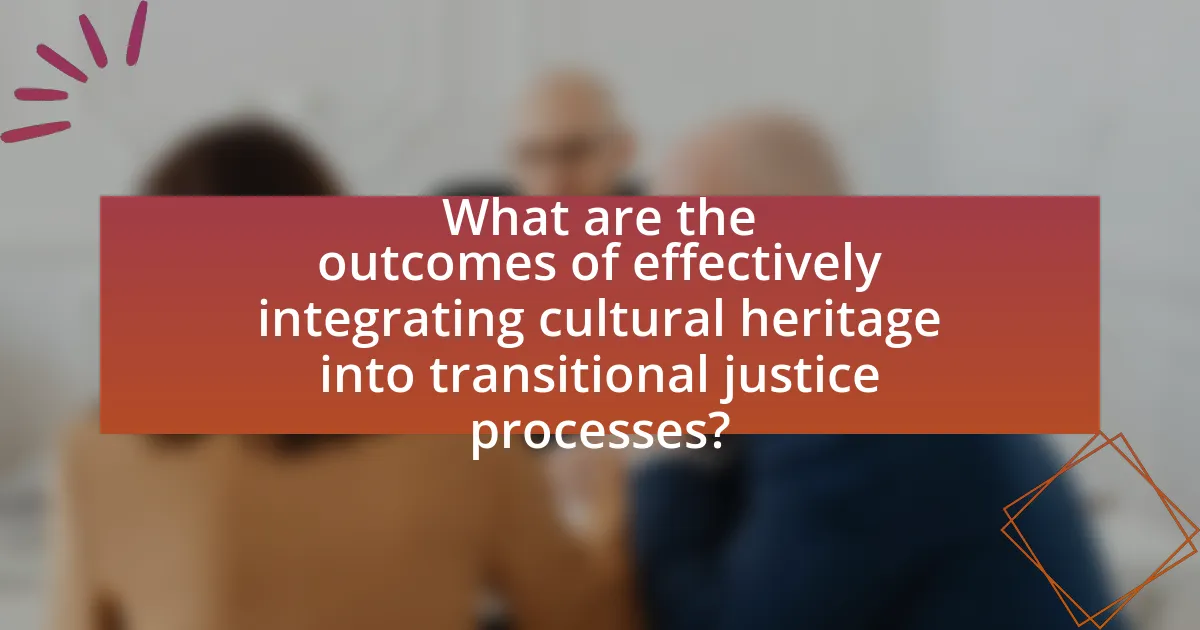
What are the outcomes of effectively integrating cultural heritage into transitional justice processes?
Effectively integrating cultural heritage into transitional justice processes leads to enhanced social cohesion and reconciliation within post-conflict societies. This integration fosters a sense of shared identity and belonging among diverse groups, which is crucial for rebuilding trust and promoting peace. For instance, the inclusion of cultural heritage in the South African Truth and Reconciliation Commission helped to acknowledge historical injustices and validate the experiences of marginalized communities, thereby facilitating healing. Additionally, recognizing and preserving cultural heritage can prevent the recurrence of violence by addressing grievances related to identity and historical narratives, as evidenced by initiatives in countries like Bosnia and Herzegovina, where cultural heritage preservation has been linked to post-war recovery and stability.
How does cultural heritage contribute to long-term peacebuilding?
Cultural heritage contributes to long-term peacebuilding by fostering a shared identity and mutual understanding among diverse communities. This shared identity can reduce tensions and promote reconciliation, as evidenced by initiatives like the UNESCO World Heritage Sites program, which encourages collaboration among nations to preserve cultural landmarks. Such collaborative efforts not only protect heritage but also create dialogue and trust, essential components for sustainable peace. Furthermore, studies have shown that communities engaged in preserving their cultural heritage are more resilient and better equipped to navigate conflicts, as they draw strength from their historical narratives and collective memories.
What case studies illustrate successful integration of cultural heritage in transitional justice?
Case studies that illustrate successful integration of cultural heritage in transitional justice include the post-apartheid South Africa Truth and Reconciliation Commission (TRC) and the cultural heritage initiatives in Bosnia and Herzegovina following the 1992-1995 war. In South Africa, the TRC incorporated cultural narratives and memorialization efforts to acknowledge the injustices of apartheid, fostering national healing and reconciliation. In Bosnia and Herzegovina, the reconstruction of cultural sites, such as the Old Bridge in Mostar, served as a symbol of unity and recovery, promoting dialogue among diverse ethnic groups. These examples demonstrate how integrating cultural heritage into transitional justice processes can enhance social cohesion and collective memory.
How can lessons learned from these case studies inform future practices?
Lessons learned from case studies on cultural heritage in transitional justice processes can inform future practices by highlighting effective strategies for community engagement and reconciliation. For instance, case studies demonstrate that involving local communities in the preservation of cultural heritage fosters a sense of ownership and promotes healing. Evidence from the post-conflict reconstruction in Bosnia and Herzegovina shows that community-led initiatives in restoring cultural sites significantly contributed to social cohesion and trust-building among diverse groups. Additionally, these case studies reveal the importance of integrating cultural heritage into legal frameworks, as seen in South Africa’s Truth and Reconciliation Commission, which utilized cultural narratives to address historical injustices. Such insights can guide policymakers and practitioners in designing inclusive and culturally sensitive approaches that enhance the effectiveness of transitional justice efforts.
What practical steps can be taken to enhance the role of cultural heritage in transitional justice?
To enhance the role of cultural heritage in transitional justice, integrating cultural heritage preservation into legal frameworks is essential. This can be achieved by establishing laws that recognize and protect cultural sites and practices affected by conflict, ensuring that they are included in reparations and restorative justice initiatives. For instance, the 2011 UNESCO Convention on the Protection of the Underwater Cultural Heritage emphasizes the importance of safeguarding cultural heritage during conflicts, providing a legal basis for its inclusion in transitional justice processes. Additionally, involving local communities in decision-making about cultural heritage can foster reconciliation and healing, as seen in post-apartheid South Africa, where community engagement in heritage projects has been pivotal in rebuilding trust.
What strategies can communities adopt to advocate for cultural heritage preservation?
Communities can adopt several strategies to advocate for cultural heritage preservation, including raising awareness, forming coalitions, and engaging in policy advocacy. Raising awareness involves organizing educational campaigns to inform the public about the significance of cultural heritage, which can lead to increased community support and participation. Forming coalitions with local organizations, cultural institutions, and stakeholders can amplify voices and resources, creating a united front for preservation efforts. Engaging in policy advocacy includes lobbying local governments to implement protective legislation and securing funding for preservation projects, as seen in successful initiatives like the National Historic Preservation Act in the United States, which has facilitated the preservation of thousands of sites since its enactment in 1966.
How can policymakers ensure the inclusion of cultural heritage in transitional justice frameworks?
Policymakers can ensure the inclusion of cultural heritage in transitional justice frameworks by integrating cultural rights and heritage preservation into legal and institutional mechanisms. This can be achieved through the establishment of policies that recognize the significance of cultural heritage in healing and reconciliation processes, as evidenced by the 2015 United Nations General Assembly resolution that emphasizes the role of cultural heritage in peacebuilding. Additionally, engaging local communities in the decision-making process ensures that their cultural narratives and practices are respected and incorporated, which is supported by case studies from post-conflict societies like Rwanda, where cultural heritage initiatives have facilitated community rebuilding.
